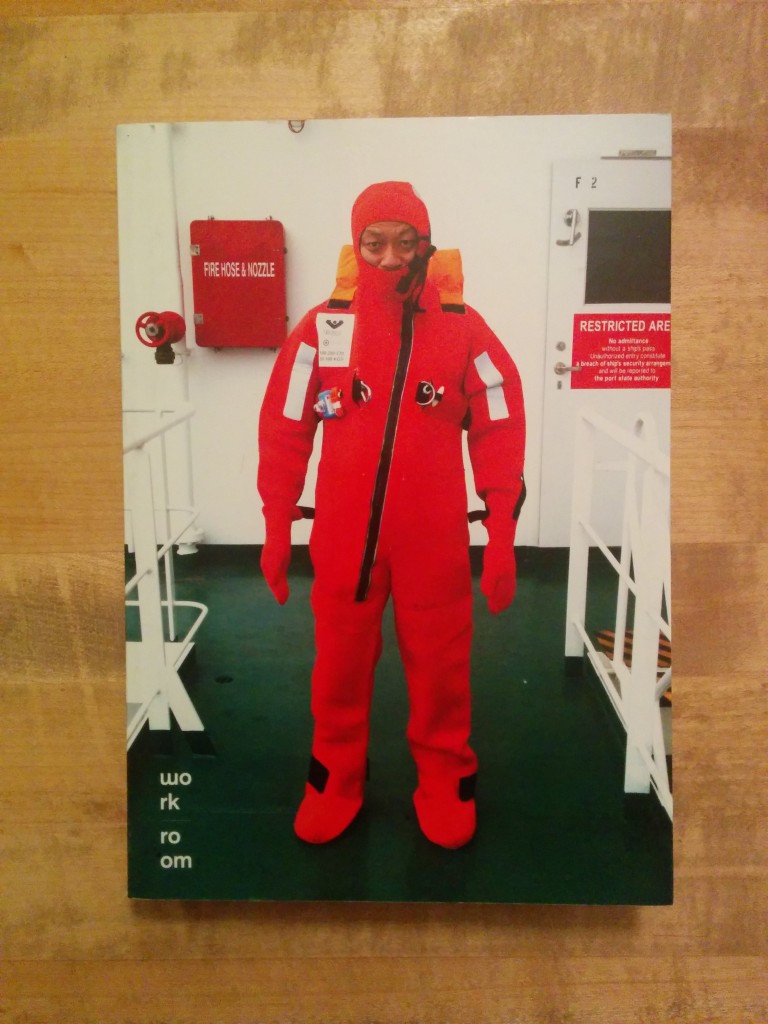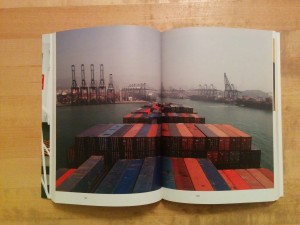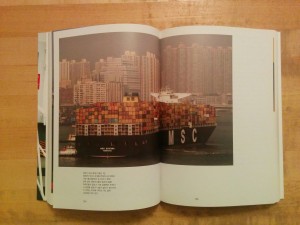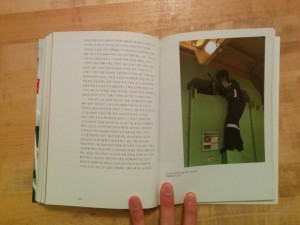
Sometimes the most interesting photography books aren’t photography centric at all. One of the first books I wrote about on this blog was Seoul Essay, which used photography to illustrate and expand the written essays that were its core content. The photographs were nonetheless fascinating. Similarly, photography is only part of Pegasus 10000 Miles; written essays (in Korean only) are the primary content of the book. (I am, as ever, treading on thin ice writing about a book which I cannot read a significant portion of.)
Pegasus 10000 Miles tracks the journey of the CMA CGM Pegasus as it makes its way around the world from Dalian to Southampton (there is a handy map that shows both the route of the Pegasus and the route of the author). This ship functions as the central narrative, but the photographs and essays are not slavishly tied to it. The ship is simply an access point allowing for the entirety of sea borne global trade–historical and contemporary, to be examined and critiqued.
Since the text is lost on me, I will confine this review to a small selection of photographs and the workmanship of workroom’s design.
I bought this book, unopened, shrink wrapped and sight-unseen because of the promise of the cover photograph. A man in a red survival suit stands stiffly on a ship’s green steel deck. Behind him are a red cabinet containing a “fire hose & nozzle” and a red “Restricted Area” sign. The railings beside him and the wall behind him are stark white. It is a classic contemporary portrait redolent of adventure and modern mitigated risk. On opening the book, the promise is largely unfulfilled. There are few photographs as starkly clean as this portrait or as technically proficient. The greatest bulk of the photographs appear to be snapshots by an amateur with a unique amount of access.
There are four photographs that sum up the book. The first is a nearly abstract view of the ship heading into the sun. The sea’s undulating surface is dappled with light and looks almost like static on a television screen. In the curved wake behind the ship the surface undulates at a lower frequency and we can see the route the ship has sailed. The ship may be the subject of the photograph, but it is the metadata left in its wake that gives us the most information.

The second image is taken from the ship’s bridge looking out across the rows of stacked shipping containers. The ship is coming into a port. Along the waterfront there are no less than 22 cranes for loading and unloading cargo. Several ships are already docked and being either loaded or unloaded. There are clearly many such ships plying the world’s waters and a complex high-tech infrastructure built around them.

On the next spread we see another cargo ship, the MSC Savona, chartered out of Monrovia, coming into port in Hong Kong (or perhaps Xiamen). This ship is even larger than the CMA CGM Pegasus–it is twenty container columns across rather than eighteen. The ship takes up nearly the entire foreground of the photograph, one can barely see the sea to either side of it. Its stacks of cargo containers neatly echo the apartment towers in the background. Two related readings of this photograph that spring immediately to mind: The city as we know it today is directly tied to the global commerce embodied in these ships. Modern life–particularly modern urban life, is significantly defined by the consumer culture represented by these ships. Without global trade, modern life would not exist as we know it.

The fourth photograph I want to talk about is of a man repairing some piece of machinery. He is perched awkwardly on a ledge and reaching into an oblong opening, which does not seem intended to be an access point. What at first appears to be blue wiring is actually nylon rope. To this point, nearly the entire focus of the photographs has been on the physical enormity of the ship, its advanced technological aspects and the complex system of ports and shipping lanes of which it is a part. Here we are seeing that for all of its marvels, it is still men who make these ships go (and who built them, for that matter). When something breaks, someone has to fix it. The photograph is one of only half a dozen or so photographs of the ship’s crew and the only one in which someone is actively doing something.
Even without the text, Pegasus 10000 Miles is a fascinating and charming glimpse into global shipping. If one were interested in shipping primarily and wanted facts rather than photographs, being unable to understand the text would be a greater concern.
Pegasus 10000 Miles
Lee Young Jun
workroom
2012